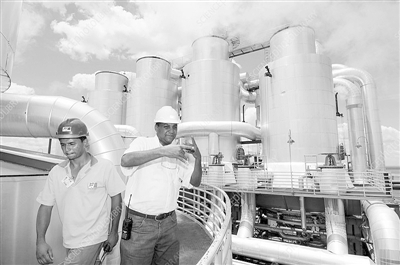


Brazil intends to prioritize the development of biofuels
date:2020-08-06 14:25:30

A biofuel production plant in Sao Paulo, Brazil. This factory uses sugar cane to produce sugar and then uses the remaining plant matter to produce ethanol fuel. Image source: Internet (media.sciencephoto.com)
At the beginning of 2020, the world suffered the most serious public health crisis in nearly a century-the new crown pneumonia epidemic. In order to prevent the spread of the epidemic, countries have entered a state of lockdown, the global economy has basically stagnated, and the demand for the oil industry has been hit hard. In the face of difficulties, the Brazilian government regards biofuels (mainly including bioethanol and biodiesel) as a priority area of technological innovation and an important way out of economic difficulties.
Long-term encouragement of the development of biofuels
Before the 1970s, Brazil basically relied on imports due to insufficient proven crude oil reserves at that time. In 1973, the world broke out for the first oil crisis. The soaring crude oil price has dealt a heavy blow to the Brazilian economy, which requires more than half of the crude oil needed to be imported. Therefore, the Brazilian government is determined to make use of the country's rich land resources and favorable agro-climatic conditions to extract ethanol fuel from sugarcane, cassava and other crops, and develop biofuel technologies represented by ethanol and biodiesel in accordance with local conditions.
In 1975, Brazil announced the implementation of the National Ethanol Plan, encouraging the use of sugar cane to produce ethanol to replace petroleum, which opened the prelude to the development of biofuels. The federal government encourages people to use ethanol fuel through subsidies, quotas, monopoly purchases of ethanol fuel, price adjustments, and administrative intervention. The Brazilian Sugarcane Industry Federation estimates that during the 40 years from 1975 to 2015, Brazil’s ethanol produced approximately 2.5 billion barrels of gasoline, successfully reducing its dependence on oil imports.
Brazil calls the traditional ethanol produced by fermentation of sugar cane as first-generation ethanol. Nowadays, Brazil's first-generation ethanol production technology is very mature. Because of the use of a special enzyme, the cost is 1/3 lower than that of the US to extract ethanol from grain. In recent years, the Brazilian government has begun to encourage the development of corn ethanol. Brazilian corn can be harvested for two seasons a year. Brazilian agricultural researchers have greatly increased the corn output through variety improvement and crop rotation. The yield of corn per hectare increased from 3000 kg per hectare in 2004/2005 to 5560 kg in 2016/2017. The substantial increase in corn output provides a new source of raw materials for the development of ethanol. In 2017, Brazil's first corn ethanol plant was put into operation in Goiás State in the Midwest.
Brazil’s biodiesel feedstock mainly uses castor beans. Brazil's largest biodiesel plant was established in Piaui State in the northeast, with an annual output of 7 million liters. However, the dry climate in the northeast limits the increase in castor oil production. Since then, Brazil has used soybean oil as the main raw material for biodiesel. Currently, 71% of the raw materials of Brazilian biodiesel come from soybean oil, 12% from beef fat, and the rest from animal fats such as pigs and chickens or vegetable oils such as cottonseed oil and palm oil.
Introduced a new national biofuel development plan
Although Brazil has become the world's second largest producer of biofuels, the current energy consumption structure of Brazilian transportation is still dominated by fossil fuels. In the energy structure of the transportation sector in 2018, gasoline accounted for 30%, ordinary diesel accounted for 45%, ethanol accounted for 15%, biodiesel accounted for only 2.4%, and the rest were natural gas and kerosene. There is still a lot of room for development and consumption demand for biofuels in Brazil.
In December 2016, the Brazilian Ministry of Mines and Energy, the Ministry of Environment and the Ministry of Agriculture jointly formulated the "National Biofuel Development Plan Draft" to regulate and encourage domestic biofuel production and application. In February 2017, the draft plan was published on the government website, and the opinions of relevant industry departments and all walks of life were widely solicited. On December 26 of the same year, the then President Temer officially approved the National Biofuel Development Plan. The plan is a strategic legal document formulated by the Brazilian government and emphasizes the important role of biofuels in ensuring national energy security and promoting economic development.
The plan clearly states that by 2030, the proportion of renewable energy in the national energy structure will be increased to 45%, of which biofuels will account for 18%. It is planned that by 2030, one-third of the country's cities will invest in the development of biofuels, which can provide approximately 150 billion reais (approximately US$28.3 billion) in output value for the national economy and create approximately 1 million jobs.
According to statistics from the Brazilian Ministry of Agriculture, Brazil’s crop planting area is approximately 64 million hectares, accounting for only 7.6% of the country’s land area. Among them, soybean planting area is 33.9 million hectares and sugarcane planting area is 9 million hectares. To expand the production of sugarcane and soybeans, Brazil has sufficient land resources. Biofuels will not conflict with food production. There is huge room for the development of biofuels in Brazil. (Deng Guoqing, our reporter based in Brazil)
Contact Us
Resolve Your Problems within One Minute



Address:No.11 Minhe Road, Private Industrial Park, Development Zone, Kaifeng City
Inquiry
If you have any questions about our company and products, please contact us immediately. Any inquiries and Suggestions would be appreciated.
We will keep your information confidential.








